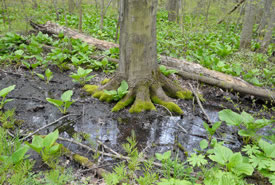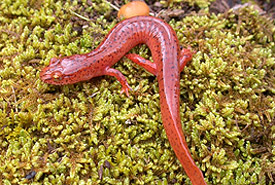Vernal pools (Part One)

Vernal pool (Photo by Bernt Solymar)
Ecosystems come in all shapes and sizes, ranging from as large as the Amazon Basin to as tiny as your backyard pond. Regardless of their size, ecosystems and habitats provide homes for animals to breed, raise their young, forage and feed.
Some ecosystems are very specific and provide a suitable home for only a handful of species. Other ecosystems can be temporary or seasonal. When an ecosystem is both species-specific and temporary, it tends to be a more important target for conservation. Vernal pools are perfect examples, but they are under threat.
The vernal in vernal pools simply refers to “spring-time,” since they are created during spring months, when precipitation is in the form of rain. When there is heavy rainfall, water that doesn’t find its way into rivers and lakes can accumulate in land depressions and valleys, forming freshwater wetlands.
Vernal pools are relatively small in comparison to other bodies of water, but the main importance is their isolation from these water systems. It means that vernal pools do not house any fish. This in turn means that both invertebrates and amphibians can lay their eggs without threats of fish eating them. Vernal pools are therefore nice little havens for tadpoles and larvae to swim around and develop into their adult form.

Spring salamander (Photo by John D. Wilson)
Now, did you know that Canada is home to 45 species of amphibians and more than 1,000 species of freshwater invertebrates? Yup, that’s a lot of toads, frogs, salamander, insects and arthropods that need ecosystems like vernal pools to begin their lifecycles.
So what’s the problem then? Well, a number of factors have raised conservationists’ concern about the viability of vernal pools. Basically vernal pools are unpredictable, and especially more so due to recent climate changes. They could or could not form, depending on the amount of rainfall. If they do form, how long will they last? How large can they get? How deep can they go? If the temperatures are too warm, vernal pools can dry up prematurely. Will invertebrates and amphibians have enough time to grow into adult form? Will the pool be large enough to house all the species? Will this be enough to sustain healthy population numbers?
These uncertainties definitely add up. We know the influence of vernal pools’ unpredictability on amphibians is especially not so good. Toads, frogs, salamanders and newts make up the amphibians, and are said to be having the hardest time adapting to pollution, climate change, invasive species and other human-induced threats. As a result, their population decline is becoming exponential.
You see, amphibians have permeable skin, which means they can “breathe” with their skin. That used to be fine, until pollution got worse and worse. Amphibians are susceptible to having toxins from the environment enter their skin and into their circulatory system. The toxic build-up is fatal. The biggest help we can offer is to protect their habitat from these harmful threats.
Stay tuned for Part Two of my blog, coming out on Oct. 11, where I will share with you some conservation efforts underway to help conserve the vernal pools and the species that rely on them.


